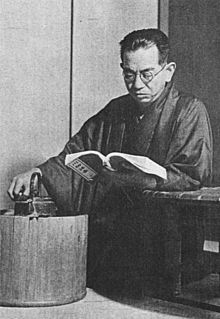Kogo Noda: Difference between revisions
Fix link |
Smooth out prose |
||
| Line 15: | Line 15: | ||
{{nihongo|'''Kogo Noda'''|野田 高梧|'''Noda Kōgo'''|November 19, 1893 – September 23, 1968, [[Hakodate, Hokkaidō]], [[Japan]]}} was a [[Japanese people|Japanese]] [[screenwriter]] most famous for collaborating with [[Yasujirō Ozu]] on many of the director's films. |
{{nihongo|'''Kogo Noda'''|野田 高梧|'''Noda Kōgo'''|November 19, 1893 – September 23, 1968, [[Hakodate, Hokkaidō]], [[Japan]]}} was a [[Japanese people|Japanese]] [[screenwriter]] most famous for collaborating with [[Yasujirō Ozu]] on many of the director's films. |
||
Born in [[Hakodate]], Noda was the son of the head of the tax bureau and younger brother to Kyūho, a [[Nihonga]] painter.<ref name="Hakodate">{{cite web|url=http://www.city.hakodate.hokkaido.jp/soumu/hensan/jimbutsu_ver1.0/b_jimbutsu/noda_ko.htm|title=Noda Kōgo|work=Hakodate jinbutsushi|publisher=City of Hakodate|language=Japanese|accessdate=29 November 2010}}</ref> He moved to [[Nagoya]] after completing elementary school and later went to [[Waseda University]].<ref name="Hakodate" /><ref name="kotobank">{{cite web|url=http://kotobank.jp/word/%E9%87%8E%E7%94%B0%E9%AB%98%E6%A2%A7|title=Noda Kōgo|work=Nihon jinmei daijiten|publisher=Kōdansha|language=Japanese|accessdate=29 November 2010}}</ref> After graduating, he worked for the city of Tokyo while also serving as a reporter for ''[[Katsudō kurabu]]'' |
Born in [[Hakodate]], Noda was the son of the head of the local tax bureau and younger brother to Kyūho, a [[Nihonga]] painter.<ref name="Hakodate">{{cite web|url=http://www.city.hakodate.hokkaido.jp/soumu/hensan/jimbutsu_ver1.0/b_jimbutsu/noda_ko.htm|title=Noda Kōgo|work=Hakodate jinbutsushi|publisher=City of Hakodate|language=Japanese|accessdate=29 November 2010}}</ref> He moved to [[Nagoya]] after completing elementary school and later went to [[Waseda University]].<ref name="Hakodate" /><ref name="kotobank">{{cite web|url=http://kotobank.jp/word/%E9%87%8E%E7%94%B0%E9%AB%98%E6%A2%A7|title=Noda Kōgo|work=Nihon jinmei daijiten|publisher=Kōdansha|language=Japanese|accessdate=29 November 2010}}</ref> After graduating, he worked for the city of Tokyo while also serving as a reporter for ''[[Katsudō kurabu]]'', one of the major film magazines, using the pen name Harunosuke Midoriyama.<ref name="Hakodate" /> On the recommendation of a scriptwriter friend from junior high, [[Takashi Oda]], he joined the script department at [[Shōchiku]] after the [[Great Kanto Earthquake]].<ref name="Hakodate" /><ref name="kotobank" /> He soon became one of the studio's central screenwriters, penning for instance ''[[Aizen katsura]]'' (1936), one of its biggest prewar hits.<ref name="Hakodate" /> |
||
He is most known for his collaborations with Ozu, which began with Noda supplying the script for the director's first feature ''[[Sword of Penitence]]'' (1927) |
He is most known for his collaborations with Ozu, which began with Noda supplying the script for the director's first feature ''[[Sword of Penitence]]'' (1927) and led to such postwar masterpieces as ''[[Tokyo Story]]'' (1953). He co-wrote thirteen of Ozu's fifteen postwar films. |
||
==References== |
==References== |
||
Revision as of 22:12, 29 November 2010
Kōgo Noda | |
|---|---|
 Kōgo Noda in 1941 | |
| Born | November 19, 1893 |
| Died | September 23, 1968 (aged 74) |
| Nationality | Japanese |
| Occupation | Screenwriter |
| Known for | Tokyo Story |
Kogo Noda (野田 高梧, Noda Kōgo, November 19, 1893 – September 23, 1968, Hakodate, Hokkaidō, Japan) was a Japanese screenwriter most famous for collaborating with Yasujirō Ozu on many of the director's films.
Born in Hakodate, Noda was the son of the head of the local tax bureau and younger brother to Kyūho, a Nihonga painter.[1] He moved to Nagoya after completing elementary school and later went to Waseda University.[1][2] After graduating, he worked for the city of Tokyo while also serving as a reporter for Katsudō kurabu, one of the major film magazines, using the pen name Harunosuke Midoriyama.[1] On the recommendation of a scriptwriter friend from junior high, Takashi Oda, he joined the script department at Shōchiku after the Great Kanto Earthquake.[1][2] He soon became one of the studio's central screenwriters, penning for instance Aizen katsura (1936), one of its biggest prewar hits.[1]
He is most known for his collaborations with Ozu, which began with Noda supplying the script for the director's first feature Sword of Penitence (1927) and led to such postwar masterpieces as Tokyo Story (1953). He co-wrote thirteen of Ozu's fifteen postwar films.
References
- ^ a b c d e "Noda Kōgo". Hakodate jinbutsushi (in Japanese). City of Hakodate. Retrieved 29 November 2010.
- ^ a b "Noda Kōgo". Nihon jinmei daijiten (in Japanese). Kōdansha. Retrieved 29 November 2010.
External links
- Noda Kōgo's grave, Rekishi ga nemuru Tama Reien Template:Ja
- Kogo Noda at IMDb
- Kogo Noda at the Japanese Movie Database (in Japanese)
